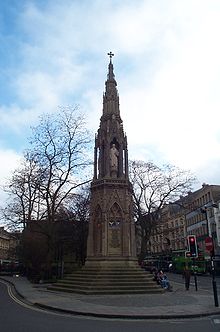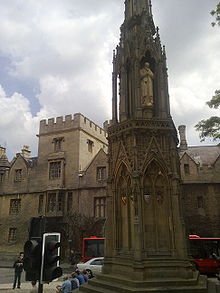- Martyrs' Memorial
-
Coordinates: 51°45′18″N 1°15′32″W / 51.75509°N 1.25901°W
The Martyrs' Memorial is a stone monument positioned at the intersection of St Giles', Magdalen Street and Beaumont Street in Oxford, England just outside Balliol College. It commemorates the 16th-century "Oxford Martyrs".
Contents
Description
Designed by Sir George Gilbert Scott, the monument was completed in 1843 after two years' work, having replaced "a picturesque but tottering old house". The Victorian Gothic memorial, whose design dates from 1838, has been likened to the steeple of a cathedral. The three statues of Thomas Cranmer, Hugh Latimer and Nicholas Ridley are by Henry Weekes.[1] The monument is listed at grade II*.[2]
The inscription on the base of the Martyrs' Memorial reads as follows:
- "To the Glory of God, and in grateful commemoration of His servants, Thomas Cranmer, Nicholas Ridley, Hugh Latimer, Prelates of the Church of England, who near this spot yielded their bodies to be burned, bearing witness to the sacred truths which they had affirmed and maintained against the errors of the Church of Rome, and rejoicing that to them it was given not only to believe in Christ, but also to suffer for His sake; this monument was erected by public subscription in the year of our Lord God, MDCCCXLI".
Cuthbert Bede (in his novel The Adventures of Mr Verdant Green) wrote about the setting of the Martyrs' Memorial thus in 1853:
- "He who enters the city, as Mr Green did, from the Woodstock Road, and rolls down the shady avenue of St Giles', between St John's College and the Taylor Buildings, and past the graceful Martyrs' Memorial, will receive impressions such as probably no other city in the world could convey."
The actual site of the execution is close by in Broad Street, located just outside the location of the old city walls. The site is marked by a cross sunk in the road.
History
As well as being a monument to the Reformation, the memorial is also a landmark of the 19th century Oxford Movement, propagated by John Keble, John Henry Newman and others. Profoundly alarmed at the Catholic realignment the movement was bringing into to the Church of England, the Rev. Golightly and other low church Anglican clergy raised the funds for erecting the monument, with its highly pro-Protestant and anti-Catholic inscription, as a public propaganda move. As a result the monument was built 300 years after the events it commemorates.[3]
The condition of the Memorial deteriorated in the twentieth century, but it underwent a full restoration in 2003, funded by Oxford City Council and the Oxford Preservation Trust.[4]
Popular rumour amongst some tour guides is that in the past students have misled foreign tourists about the nature of the Memorial and convinced them it was the spire of an underground church. This would result in the tourists venturing down a flight of stairs near the Memorial which actually lead to the public toilets.[5]
References
- ^ "Stevens T. 'Weekes, Henry (1807–1877)', Oxford Dictionary of National Biography (2004)". Oxford University Press. http://www.oxforddnb.com/view/article/28969. Retrieved 2008-03-19.
- ^ "Images of England: The Martyrs' Memorial". English Heritage. http://www.imagesofengland.org.uk/details/default.aspx?id=245634. Retrieved 2008-03-19.
- ^ "The Martyrs' Memorial at Oxford". The Journal of Ecclesiastical History. http://www.accessmylibrary.com/coms2/summary_0286-4157139_ITM*. Retrieved 2008-08-21.
- ^ Martyrs' Memorial at local history website
- ^ Sightseeing, OxfordCityGuide.com. Retrieved 24 May 2011.
See also
Categories:- 1843 establishments in England
- History of Oxford
- Visitor attractions in Oxford
- Monuments and memorials in England
- Buildings and structures in Oxford
- Christianity in Oxford
- Martyrs' monuments and memorials
Wikimedia Foundation. 2010.


